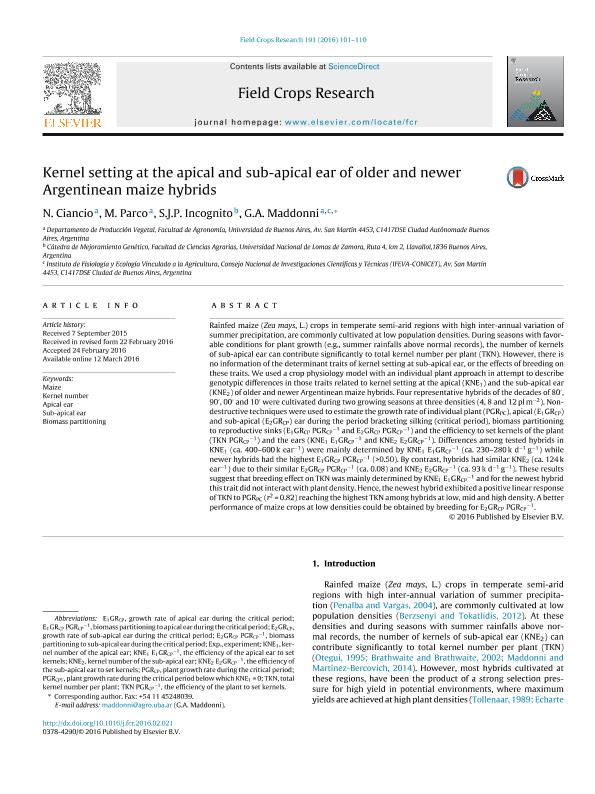Mostrar el registro sencillo del ítem
dc.contributor.author
Ciancio, Nicolás

dc.contributor.author
Parco, Martín

dc.contributor.author
Incognito, Salvador Juan Pablo

dc.contributor.author
Maddonni, Gustavo Angel

dc.date.available
2018-04-27T19:38:38Z
dc.date.issued
2016-05
dc.identifier.citation
Ciancio, Nicolás; Parco, Martín; Incognito, Salvador Juan Pablo; Maddonni, Gustavo Angel; Kernel setting at the apical and sub-apical ear of older and newer Argentinean maize hybrids; Elsevier Science; Field Crops Research; 191; 5-2016; 101-110
dc.identifier.issn
0378-4290
dc.identifier.uri
http://hdl.handle.net/11336/43734
dc.description.abstract
Rainfed maize (Zea mays, L.) crops in temperate semi-arid regions with high inter-annual variation of summer precipitation, are commonly cultivated at low population densities. During seasons with favorable conditions for plant growth (e.g. summer rainfalls above normal records), the number of kernels of sub-apical ear can contribute significantly to total kernel number per plant (TKN). However, there is no information of the determinant traits of kernel setting at sub-apical ear, or the effects of breeding on these traits. We used a crop physiology model with an individual plant approach in attempt to describe genotypic differences in those traits related to kernel setting at the apical (KNE1) and the sub-apical ear (KNE2) of older and newer Argentinean maize hybrids. Four representative hybrids of the decades of 80´, 90´, 00´ and 10´ were cultivated during two growing seasons at three densities (4, 8 and 12 pl m-2). Nondestructive techniques were used to estimate the growth rate of individual plant (PGRPC), apical (E1GRCP) and sub-apical (E2GRCP) ear during the period bracketing silking (critical period), biomass partitioning to reproductive sinks (E1GRCP PGRCP-1 and E2GRCP PGRCP-1) and the efficiency to set kernels of the plant (TKN PGRCP-1) and the ears (KNE1 E1GRCP-1 and KNE2 E2GRCP-1). Differences among tested hybrids in KNE1 (ca. 400 to 600 k ear-1) were mainly determined by KNE1 E1GRCP-1 (ca. 230 to 280 k d-1 g-1) while newer hybrids had the highest E1GRCP PGRCP-1 (> 0.50). In contrast, hybrids had similar KNE2 (ca. 124 k ear-1) due to their similar E2GRCP PGRCP-1 (ca. 0.08) and KNE2 E2GRCP-1 (ca. 93 k d-1 g-1). These results suggest that breeding effect on TKN was mainly determined by KNE1 E1GRCP-1 and for the newest hybrid this trait did not interact with plant density. Hence, the newest hybrid exhibited a positive linear response of TKN to PGRPC (r2 = 0.84) reaching the highest TKN among hybrids at low, mid and high density. A better performance of maize crops at low densities could be obtained by breeding for E2GRCP PGRCP-1.
dc.format
application/pdf
dc.language.iso
eng
dc.publisher
Elsevier Science

dc.rights
info:eu-repo/semantics/openAccess
dc.rights.uri
https://creativecommons.org/licenses/by-nc-sa/2.5/ar/
dc.subject
APICAL EAR
dc.subject
BIOMASS PARTITIONING
dc.subject
KERNEL NUMBER
dc.subject
MAIZE
dc.subject
SUB-APICAL EAR
dc.subject.classification
Agricultura

dc.subject.classification
Agricultura, Silvicultura y Pesca

dc.subject.classification
CIENCIAS AGRÍCOLAS

dc.title
Kernel setting at the apical and sub-apical ear of older and newer Argentinean maize hybrids
dc.type
info:eu-repo/semantics/article
dc.type
info:ar-repo/semantics/artículo
dc.type
info:eu-repo/semantics/publishedVersion
dc.date.updated
2018-04-27T14:00:00Z
dc.journal.volume
191
dc.journal.pagination
101-110
dc.journal.pais
Países Bajos

dc.journal.ciudad
Amsterdam
dc.description.fil
Fil: Ciancio, Nicolás. Consejo Nacional de Investigaciones Científicas y Técnicas; Argentina. Universidad de Buenos Aires. Facultad de Agronomía. Departamento de Producción Vegetal; Argentina
dc.description.fil
Fil: Parco, Martín. Universidad de Buenos Aires. Facultad de Agronomía. Departamento de Producción Vegetal; Argentina
dc.description.fil
Fil: Incognito, Salvador Juan Pablo. Consejo Nacional de Investigaciones Científicas y Técnicas; Argentina. Universidad Nacional de Lomas de Zamora; Argentina
dc.description.fil
Fil: Maddonni, Gustavo Angel. Consejo Nacional de Investigaciones Científicas y Técnicas. Oficina de Coordinación Administrativa Parque Centenario. Instituto de Investigaciones Fisiológicas y Ecológicas Vinculadas a la Agricultura. Universidad de Buenos Aires. Facultad de Agronomía. Instituto de Investigaciones Fisiológicas y Ecológicas Vinculadas a la Agricultura; Argentina. Universidad de Buenos Aires. Facultad de Agronomía. Departamento de Producción Vegetal; Argentina
dc.journal.title
Field Crops Research

dc.relation.alternativeid
info:eu-repo/semantics/altIdentifier/doi/http://dx.doi.org/10.1016/j.fcr.2016.02.021
dc.relation.alternativeid
info:eu-repo/semantics/altIdentifier/url/https://www.sciencedirect.com/science/article/pii/S0378429016300478
Archivos asociados
